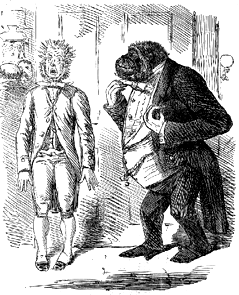

 his cartoon, "The Lion of the Season", in Punch of May 25, 1861, refers specifically to the French-American explorer, Paul du Chaillu (1835-1903), whose book, Explorations and Adventures in Equatorial Africa: with Accounts of the Manners and Customs of the People, and of the Chase of the Gorilla, the Crocodile, Leopard, Elephant, Hippopotamus, and other Animals, had just been published in London. The book caused some excitement, particularly due to the eyewitness accounts of gorillas, which had hitherto been known to scientists only through their skeletons; it also caused some doubts as to its truthfulness. Thus du Chaillu was the focus of much public attention at this time, and was described by James Hunt in his article "Savage Africa" as "that brave traveller and explorer who was made by his injudicious friends, for their glory, the lion of the season for 1861."(1)
his cartoon, "The Lion of the Season", in Punch of May 25, 1861, refers specifically to the French-American explorer, Paul du Chaillu (1835-1903), whose book, Explorations and Adventures in Equatorial Africa: with Accounts of the Manners and Customs of the People, and of the Chase of the Gorilla, the Crocodile, Leopard, Elephant, Hippopotamus, and other Animals, had just been published in London. The book caused some excitement, particularly due to the eyewitness accounts of gorillas, which had hitherto been known to scientists only through their skeletons; it also caused some doubts as to its truthfulness. Thus du Chaillu was the focus of much public attention at this time, and was described by James Hunt in his article "Savage Africa" as "that brave traveller and explorer who was made by his injudicious friends, for their glory, the lion of the season for 1861."(1)The gorilla, smiling somewhat ambiguously and adjusting his white tie, here represents three currents of thought in 1861. First, the explorer was a new form of hero, the man of the hour. The Victorians were interested in the exotic, in life and death adventures which could transport them, temporarily and in imagination of course, away from their comfortable, well-ordered middle-class lives. Exploration represented partly intellectual, scientific study and partly high drama. Secondly, the gorilla, though caricatured here in a civilized English setting, was nevertheless a dangerous wild animal, just as Africa was considered thoroughly savage, with its diseases, its fearsome wild life, its impenetrable interior, and its primitive, ignorant natives. Africa could perhaps be conquered but not really understood. Thirdly, Darwin's Origin of Species, in 1879, had just solidified the conclusions of years of scientific study showing that amoral evolution and adaptation, rather than divinely ordained creation, were the explanation for life on earth. This gorilla, therefore, could theoretically be closely related to man. A convincing, growing body of evidence indicated that British Victorian manhood, that flower of civilization, was probably more closely connected with the great ape than with God. Thus, the stylishly turned-out gorilla in evening dress, entering a party during the London "season" says it all; it is humorous and at the same time very alarming in its implications.
Another facet of this cartoon is a jab at the Irish. In a later Punch cartoon, Mr. Gorilla's name was written even more explicitly as Mr. G. O'rilla. Furthermore, it had been thought at one time that the gorilla might possibly be the "missing link" in man's evolutionary past. Thus, there is suggested here the hint of a connection between the Irish, the gorilla, and the "missing link".
[Victorian initial "T" by Harlan Wallach ęcopyright 1994.]
Return to Punch page.